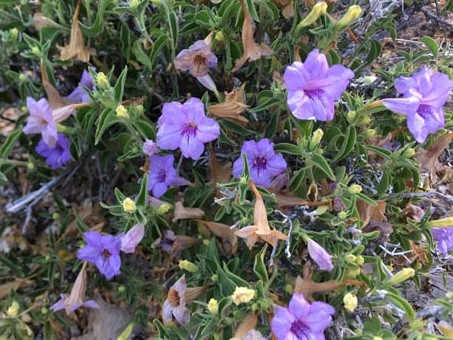This section contains entries about our botanizing in Baja California written for the UC BEE (Oct 2012 to Aug 2021)
and The UC Bee Hive (2022-), monthly newsletters for volunteers and staff of the UC Berkeley Botanical Garden.
Click on any photo for a larger image.
< < < Back to Day 1
Santa Martha Arqueological Site — Day 2*
The following morning dawned clear and crisp, probably in the 50s, and it was a relief after the previous day´s heat. Wandering around in the bushes in my jammies in the early light was refreshing. And I was able to enjoy the coolness while taking photos of some flowers before the rising heat got to them.
Baja California Ruellia (Ruellia californica subsp. californica) in a shady spot. The species was blooming abundantly throughout the area.
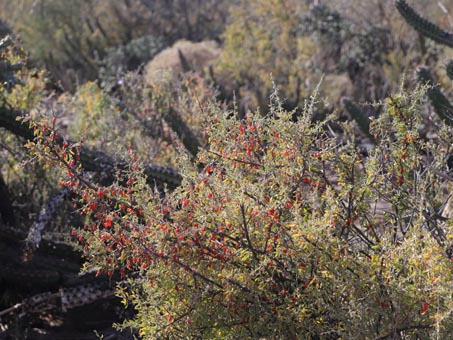
The Desert Thorn (Lycium andersonii) from near Rancho la Cerquita all the way to Santa Martha were ablaze with copious berries.
As if everything we'd already seen so far hadn't blown my mind, it happened again right after returning to camp from my morning foray into the bushes. I´d been talking to my friend when I happened to glance over at the Cochal cactus (Myrtillocactus cochal) just a few feet away at the edge of camp. I was speechless as I pointed it out to her once I had finally realized it was festooned with greenish-white, star-shaped flowers which were alive with bees.
I hadn't known that it was a night bloomer, but given its color it made sense that it would be attractive to bats and moths. And this morning as the sun continued to rise, it was abuzz with bees, their bulging pollen pouches like fat white balls stuck to their legs. They paid no attention to me or my camera lens as they went about their business.
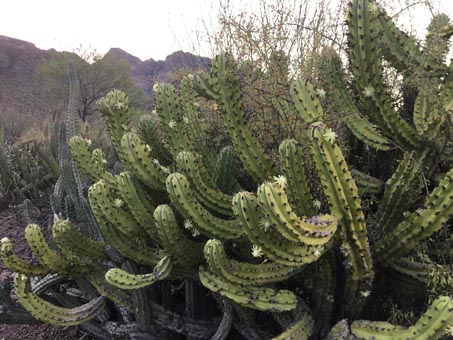
Just a part of the endemic Cochal (Candelabra cactus, Myrtillocactus cochal), with its night-blooming flowers.
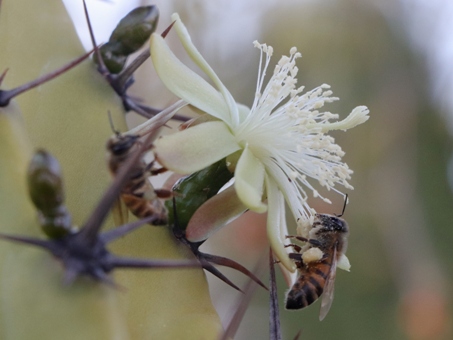
Honey bees busy at work. Look at that pollen sac on the lower bee!
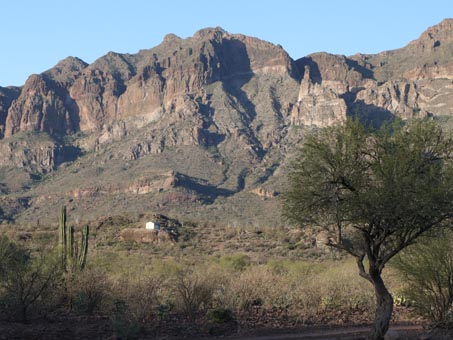
Morning begins in Santa Martha. What a view. And it was cool, too.
After breakfast, we headed up the road about a mile to Rancho El Sauce to meet up with Patricio and sign in and pay for the trip permits. It was only about 8 am but the morning's coolness was starting to fade. We were to meet the guide at the trailhead at 9 am and we were already wondering if we should have started out even earlier.
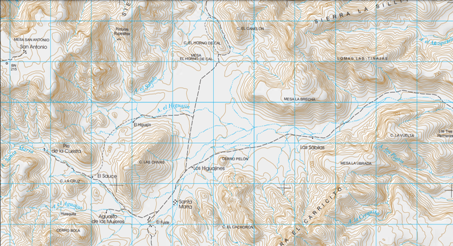
Topo map of the area. Click to zoom in for details. Our destination for the day is labeled as Pinturas Rupestres on the map (Photo source: INEGI Topo Map G12A24, square with x axis = 06-07, y axis = 52-51).
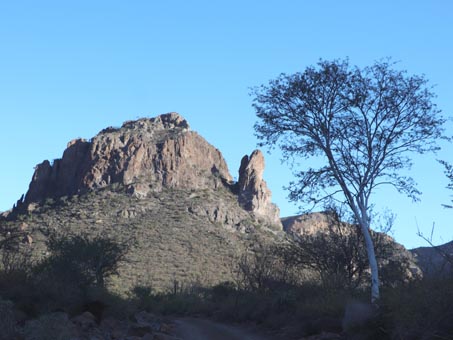
One of the small cerros near Rancho El Sauce.
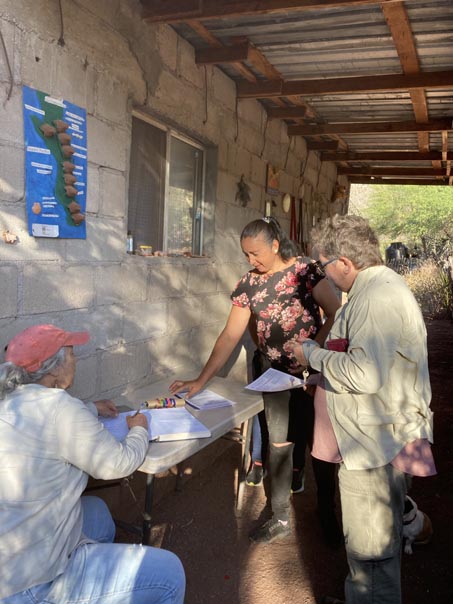
Signing the INAH registry at Rancho el Sauce before our ride.
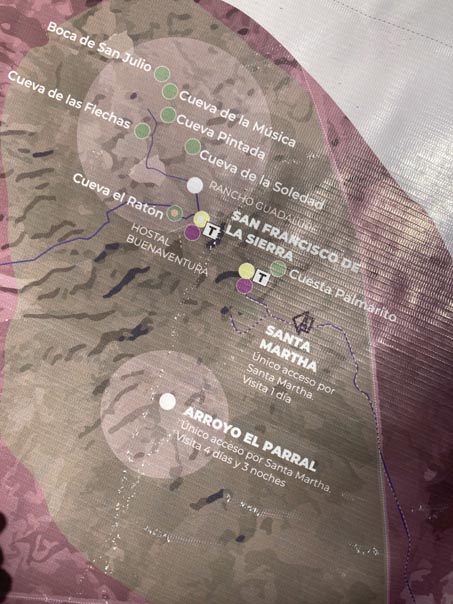
Map showing rock art sites in the area. We were amazed to see that San Francisco de la Sierra was only about 5 miles from our location as the crow flies but it's only accessible on foot or by mule from here.
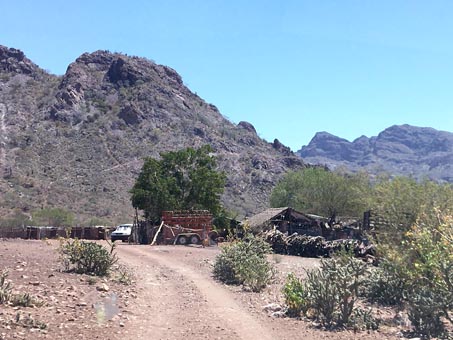
With Rancho el Sauce behind us, we retraced our steps a few hundred meters & turned left by the buildings toward the trailhead at El Higuajín. Rancho Santa Martha is behind the near ridge about a mile or so by road.
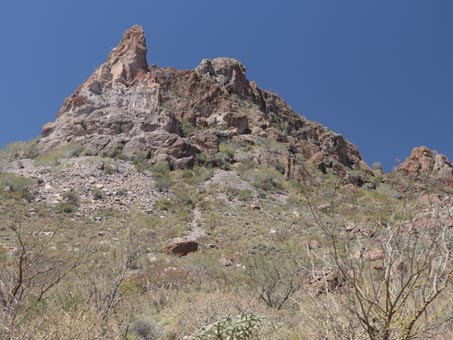
Nearing El Higuajín. The outcrops along here to the north form the lower flanks of the Sierra Borcelano where El Palmarito is located.
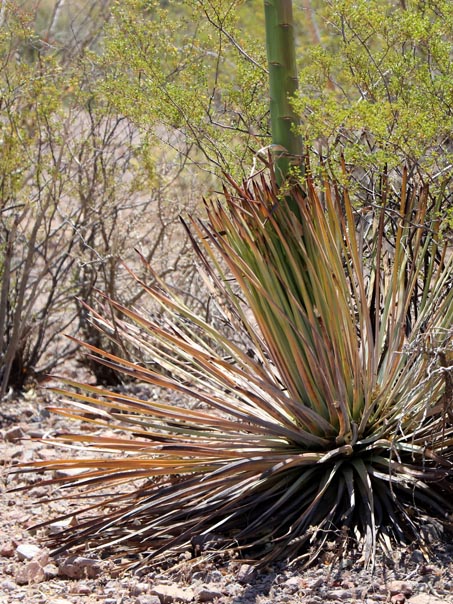
Chaparral Candle / Lechuguilla (Hesperoyucca whipplei) is more common in northern BC. Leaves are fibrous.

In the sierras here, Chaparral Candle is found at higher elevations. This fruiting stalk was c. 2 m tall.
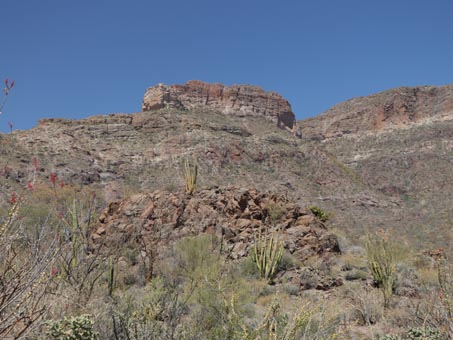
Approaching the trailhead. The hills are steep & rocky. Looking towards Mesa San Antonio which backs the rock art site to the northwest.
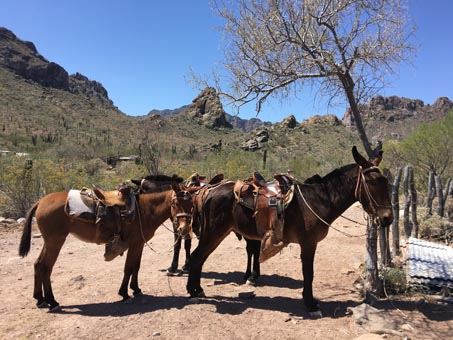
Our sure-footed mulish mounts await us at the trail head.
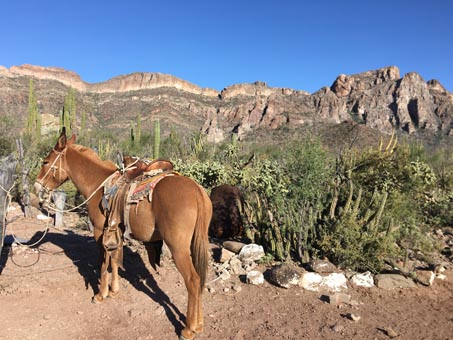
Our guide's mount with Mesa San Antonio behind.
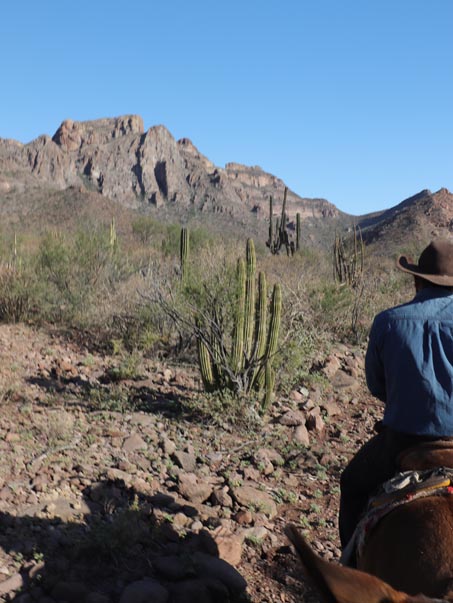
And we're off! See that dip in the top far right ridge and the dark cactus to its left? Our destination is just behind the cactus stems.
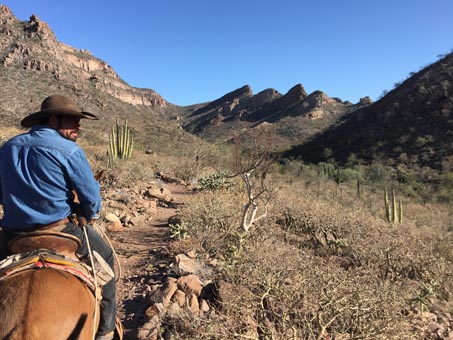
The Organpipe Cactus to the right of our guide's head points the way.
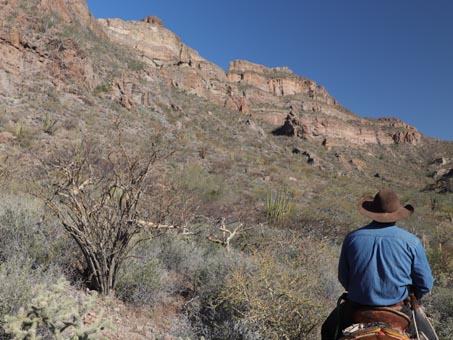
The trail is c. 2.64 km (1.64 mi) and on mule took us about an hour.
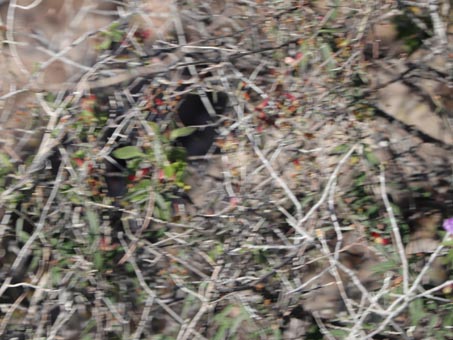
The back of a moving mule climbing a steep & windy trail is not the best place for taking good plant photos, so most turned out like this! Ruellia californica & Slender Cottsia/Fermina (Cottsia gracilis), BTW.
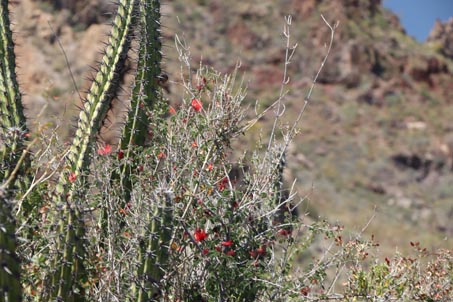
Galloping cactus provides the ladder for Slender Cottsia/Fermina, a woody perennial vine (samaras visible lower right). Fairy Duster (Calliandra californica) is growing up from within the cactus.
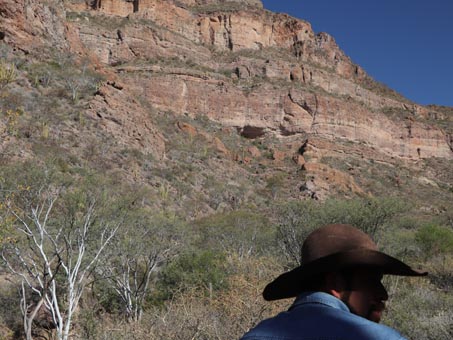
Getting closer. The dark spot on the cliff above our guide's head...
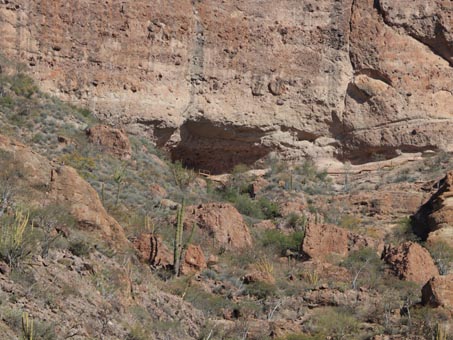
... is our destination. Zooming in will reveal the walkways.
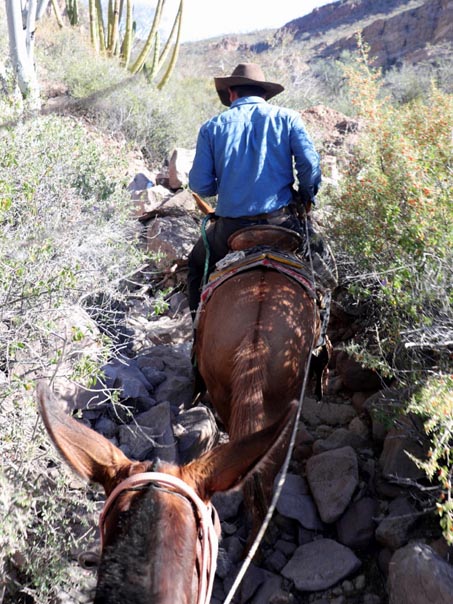
As we got higher up the canyon, the trail narrowed & in places the mules were walking over large rocks.
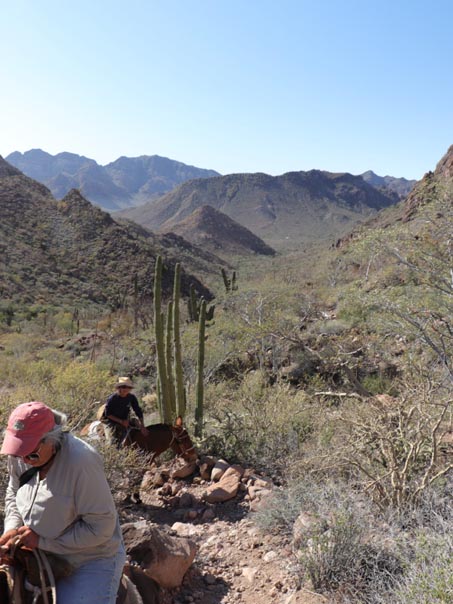
Looking down the switchback at my companions.
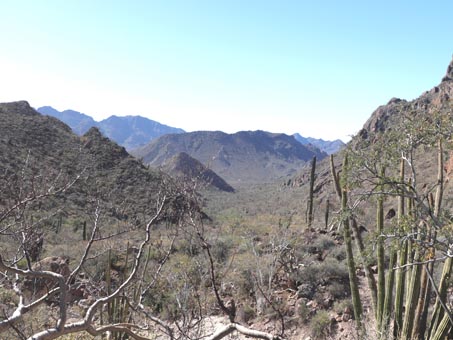
The view back towards the trailhead was breaktaking. The more or less flat hill in the middle distance is Cerro las Chivas & to the left, Sierra el Carricito. Rancho Sta. Martha is nestled in between the two.
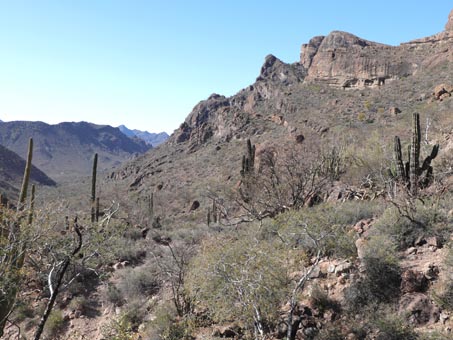
The hillside we were climbling up was the flank of Sierra Borcelano, home to other rock art sites.

Taking a short stop on the steepest part of the trail near the top.
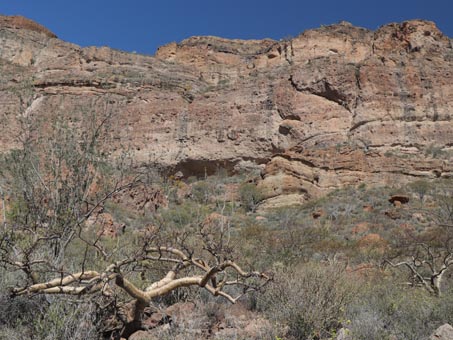
Many of the Elephant Trees (Bursera microphylla) on the upper slopes were squat and wide spread. The cave is visible above the tree.
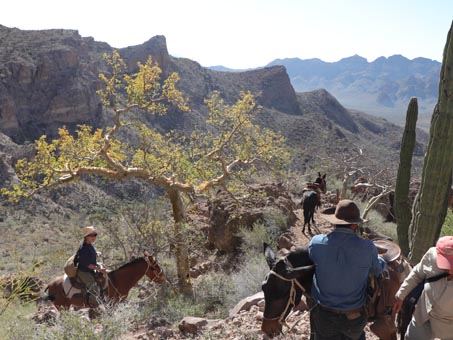
This was as far as we could go on the mules, just below the fence line of the enclosed area. The hillside dropped off on three sides of us.
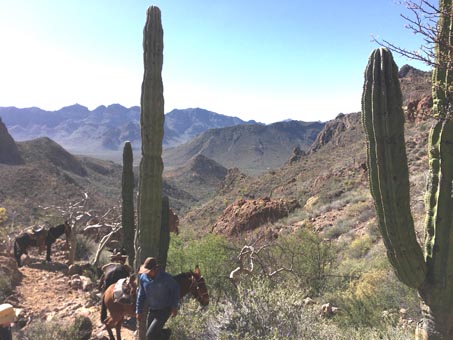
From here, we had to climb a very loose, steep trail about 20 m. My legs were already shaking from the ride & I wasn't looking forward to this last part. Thankfully, I had my cane & a hand up from the guide.
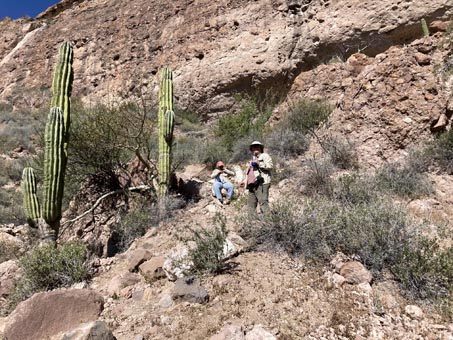
About halfway uphill from where we dismounted and the fence line.
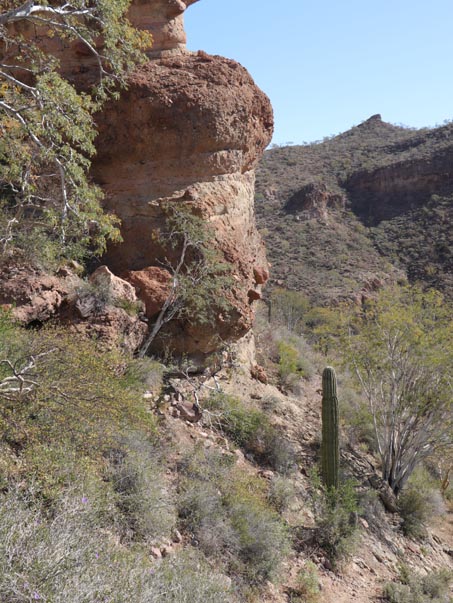
Wobbly legs and this terrain don't go well together.
El Palmarito
This site is really a rock overhang rather than a cave. In typical Great Mural Style, the art has been done on a grand scale, though individual images may be anywhere from greater to lesser than lifesize. See Cave Paintings and Cowboys on my website for a more detailed description of the art and various sites on the Baja California peninsula.
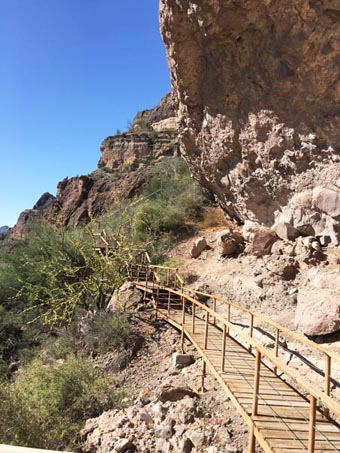
Looking west along the cave.
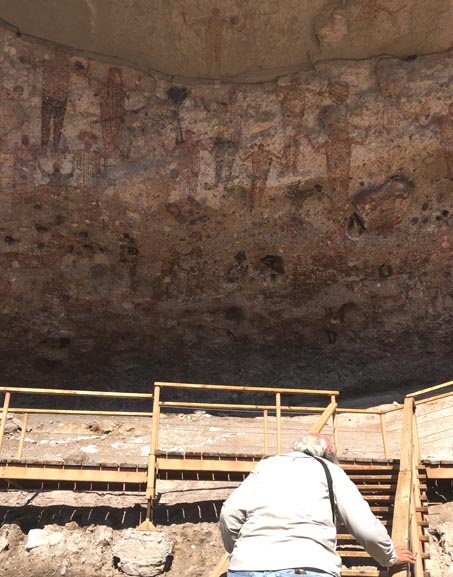
My friend climbing the last part of the stairs to the platform.
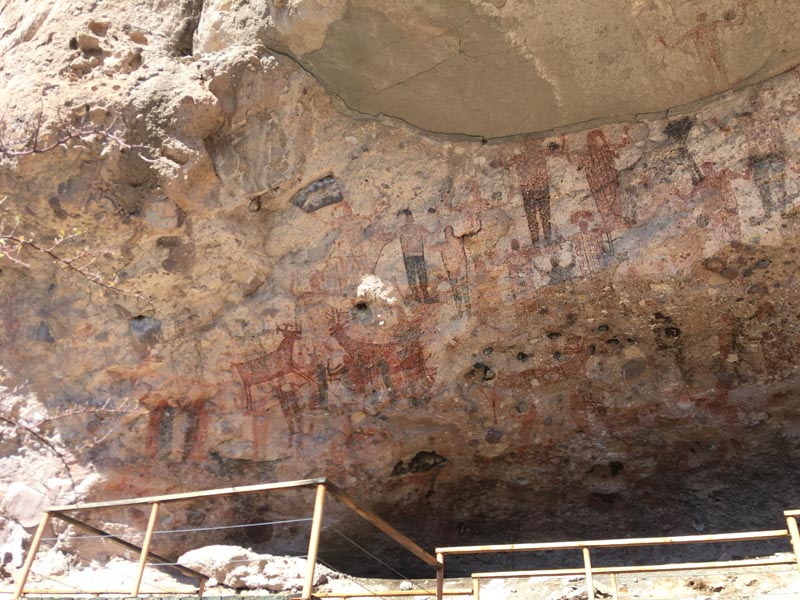
What you see as you come up the stairs looking left...
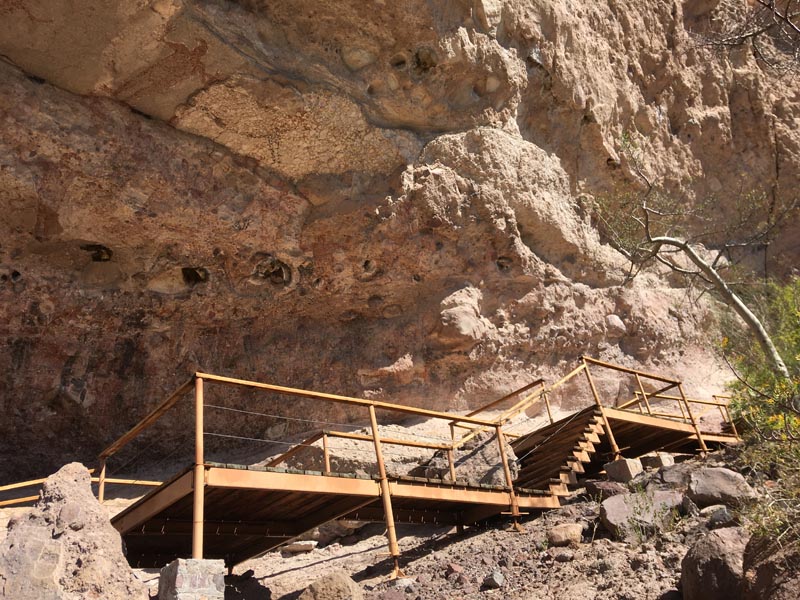
... and looking to the right.
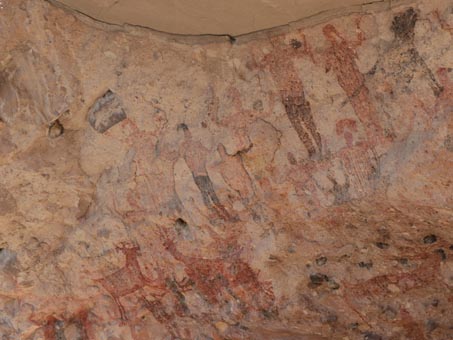
The overhang is huge and the art high overhead.
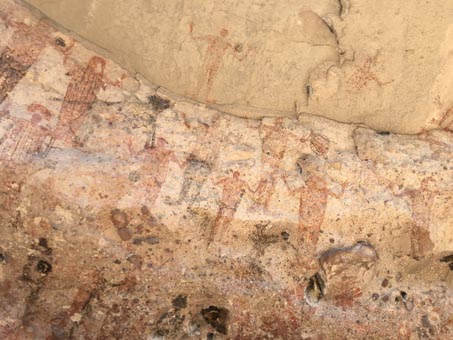
Monos (male & female anthropomorphic figures), chamanes (with headdresses), deer and pronghorn antelope seem to dominate.
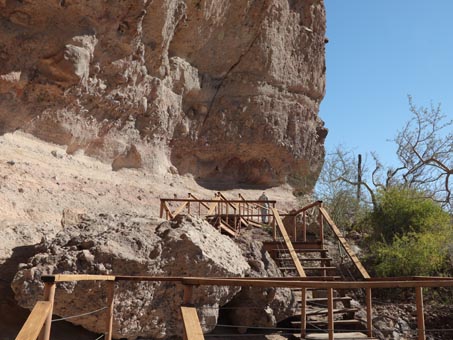
The scale of the overhang, located on a steep hillside, is staggering.
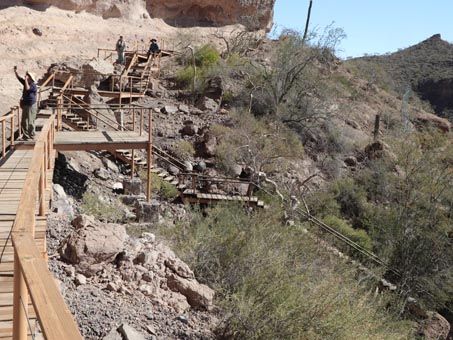
The viewing platform extends for most of the site. Note the stairs.

The view to the left (west) of the overhang.
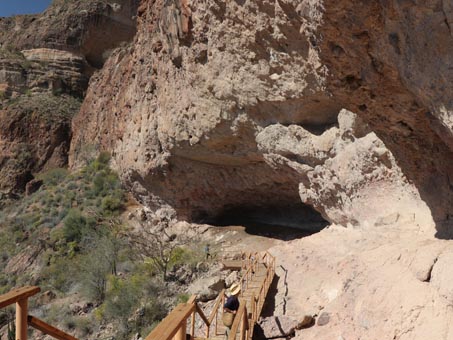
Same view, from the far right (east) of the platform.
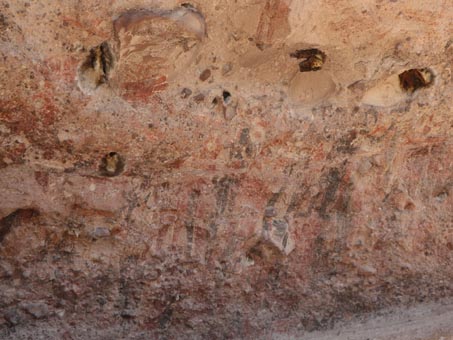
Some portions of the artwork are difficult to decipher...
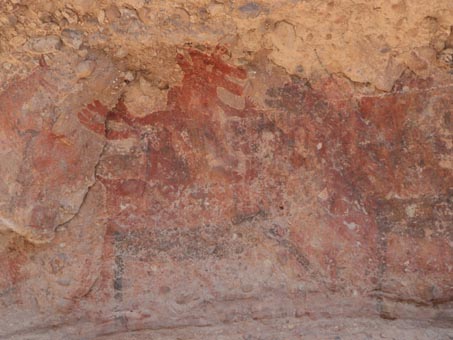
...due to overlapping and erosion.
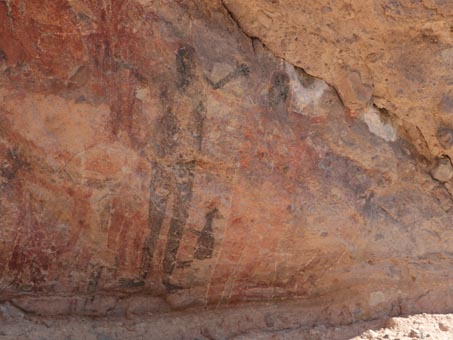
Overlapping monos of varying sizes and a black Jackrabbit.
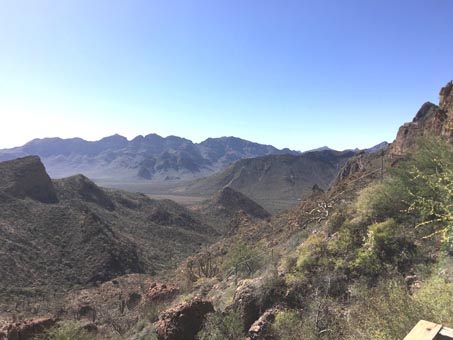
View from the top. It was getting hot on the exposed cliff so it was soon time to head back down to the mules and the trail.
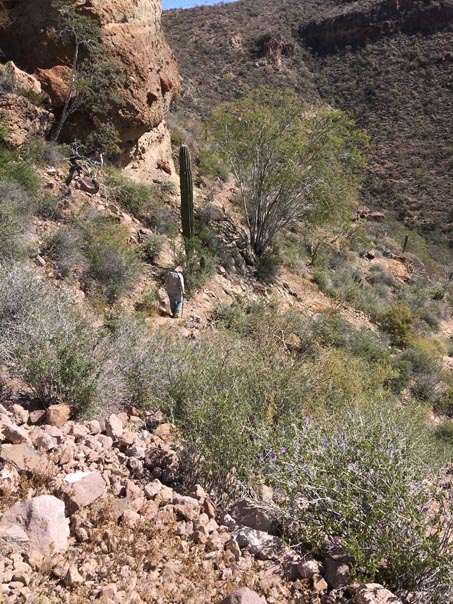
My friend couldn't bear to ride the mule down the steepest part of the trail so she borrowed my cane.
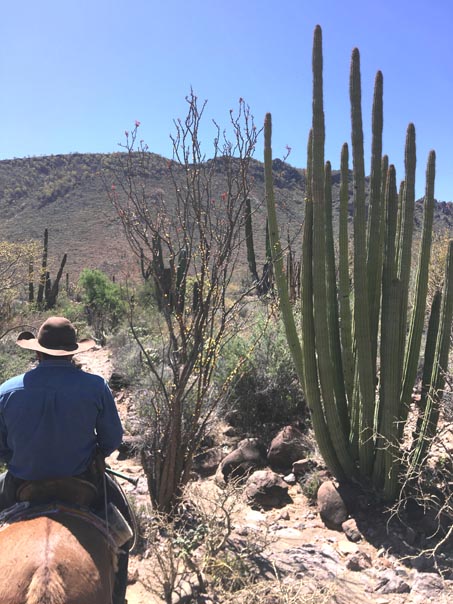
Organpipe cactus (Stenocereus thurberi) were one of the tallest plants on the hillside.
I thought the descent on the mule was much harder than the ascent: the "wings" on the front of the saddle pinched my thighs, my knees were already mush, my "bad" foot was asleep, I was baking in the sun and it just seemed interminable. On the ride downhill, you can be sure the phrase "What was I thinking?!" passed through my mind a number of times.
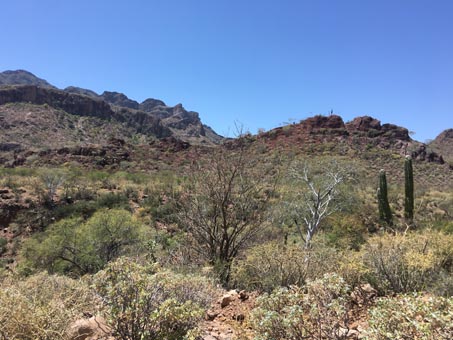
Finally back to the flat, easy part of the trail near the trailhead.

It was such a relief to finally get off the mules and walk out the kinks, and get circulation restarted in my butt and foot. Adios, amigos! It was an amazing ride.
In spite of being exhausted after the ride, I don't think any of us regretted taking the time to see the rock art at El Palmarito; but we were definitely not ready for the three day mule trip to El Parral that Patricio suggested jokingly once we staggered from the car to his porch for a visit with him and his family and to purchase some of their goat cheese. For us, at this point in our lives, the day trip was a once in a lifetime experience. I know that for me, any future rides are going to be a lot more tame and on mostly level ground.
Our trip wasn't over yet at this point. We still had to break camp, and drive back to the highway and then on to the Ecolodge for the night. Fortunately for us all, the weather was slightly cooler than yesterday and the hot wind decreased over the afternoon. After a hot shower, we spent a pleasant evening back at the lodge with good food and company and a long, deep sleep. On our final day, the morning dawned clear and cool and we spent our last few hours on the front deck of our cabin enjoying the vista across the valley to the towering Volcan Tres Virgenes. Sadly, we finally packed up and made our goodbyes to Oscar and Maria before heading home to Mulegé.
< < < Back to Day 1
We've reached the end of the trail for now. Sure hope you enjoyed the trip. We certainly did. We´ve had all summer to recover and think about upcoming trips to take this coming season on our return to Mulegé. Stay tuned, and until then, hasta luego...
Debra Valov—Curatorial Volunteer
* This entry was to appear in the Nov 2022 issue of the Beehive, but publication was delayed due to staffing issues.
References and Resources
Rebman, J. P., J. Gibson, and K. Rich, 2016. Annotated checklist of the vascular plants of Baja California, Mexico. Proceedings of the San Diego Society of Natural History, No. 45, 15 November 2016. San Diego Natural History Museum, San Diego, CA. Full text available online.
Rebman, J. P and Roberts, N. C. (2012). Baja California Plant Field Guide. San Diego, CA: Sunbelt Publications. Descriptions and distribution.
Wiggins, I. L. (1980). The Flora of Baja California. Stanford University Press. Keys and descriptions.


